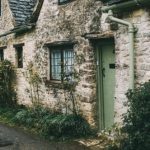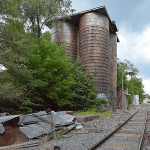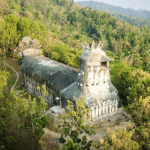 Technology
Technology  Technology
Technology  Humans
Humans 10 Everyday Human Behaviors That Are Actually Survival Instincts
 Animals
Animals 10 Animals That Humiliated and Harmed Historical Leaders
 History
History 10 Most Influential Protests in Modern History
 Creepy
Creepy 10 More Representations of Death from Myth, Legend, and Folktale
 Technology
Technology 10 Scientific Breakthroughs of 2025 That’ll Change Everything
 Our World
Our World 10 Ways Icelandic Culture Makes Other Countries Look Boring
 Misconceptions
Misconceptions 10 Common Misconceptions About the Victorian Era
 Mysteries
Mysteries 10 Strange Unexplained Mysteries of 2025
 Miscellaneous
Miscellaneous 10 of History’s Most Bell-Ringing Finishing Moves
 Technology
Technology Top 10 Everyday Tech Buzzwords That Hide a Darker Past
 Humans
Humans 10 Everyday Human Behaviors That Are Actually Survival Instincts
 Animals
Animals 10 Animals That Humiliated and Harmed Historical Leaders
Who's Behind Listverse?

Jamie Frater
Head Editor
Jamie founded Listverse due to an insatiable desire to share fascinating, obscure, and bizarre facts. He has been a guest speaker on numerous national radio and television stations and is a five time published author.
More About Us History
History 10 Most Influential Protests in Modern History
 Creepy
Creepy 10 More Representations of Death from Myth, Legend, and Folktale
 Technology
Technology 10 Scientific Breakthroughs of 2025 That’ll Change Everything
 Our World
Our World 10 Ways Icelandic Culture Makes Other Countries Look Boring
 Misconceptions
Misconceptions 10 Common Misconceptions About the Victorian Era
 Mysteries
Mysteries 10 Strange Unexplained Mysteries of 2025
 Miscellaneous
Miscellaneous 10 of History’s Most Bell-Ringing Finishing Moves
10 Buildings That Were Put Up or Modified out of Spite
Every so often, buildings are put up not out of need or passion but out of spite. These so-called spite houses are built or modified with the specific intent of irritating the neighbors. Although their initial purpose is to annoy, they occasionally become tourist attractions. Here are 10 of the most interesting (and sometimes strange!) buildings that have been modified or built out of spite.
Related: 10 Eerie Ghost Cities Left Behind by the Soviet Union
10 Carbisdale Castle in Scotland
In 1889, Mary Caroline Blair married George Sutherland-Leveson-Gower, the 3rd Duke of Sutherland. She became the Duchess of Sutherland—much to the displeasure of his family. It should come as no surprise then that when he died in 1892, his will was contested. In an attempt to secure a sizeable inheritance, the Duchess burned documents, but she was found guilty of this crime and spent six weeks in prison.
The family decided to buy her off by giving her the money to build a castle, as long as it was located outside of their estate. The Duchess, feeling scorned, bought a piece of land right on the edge of the estate and had her castle built on a hillside that overlooked their land, ensuring that it would be visible from large portions of their property. As well as a spiteful backstory, the castle comes with 20 acres of land and a loch.[1]
9 Miracle House in New York, USA
In the early 1900s, property developer John Randall was irritated to learn that a rival developer was planning a grid layout in Freeport, New York, which he was opposed to. He had to act quickly if he wanted to stop them, so in a single day, he had a spite house built on a triangular piece of land that was right in their way. This move forced the developers to bend the road to accommodate the already-built house.
Today, a marker at the house reads: “Built in one day to spite a competitor’s efforts in a real estate development race. This forever changed the layout of Lena Avenue and added Wilson Place.” The Brooklyn Daily Eagle reported that Randall was against the planned layout because “a straight line would reduce his frontage of land so as to make it worthless.”[2]
8 The Cake House in Connecticut, USA
Gaylordsville, Connecticut, is home to a run-down spite house that resembles a five-tier wedding cake. The strange house was built in protest by Jan Pol after the authorities took custody of his 15-year-old foster daughter and her baby in 1961. Pol was accused of fathering the baby himself, which he vehemently denied. As well as putting up the cake-like building along Route 7 in protest, he also published a book, Jan Pol: The Passage of My Life (1977), to give his version of events.
Commenting on his foster daughter’s pregnancy, he states, “I could not chain the girl up and always watch what she was doing.” No criminal charges were brought against him, but custody was never restored. He had hoped that he and his wife would be reunited with the girls and they could all live in the house, but it never came to pass.[3]
7 The Equality House in Kansas, USA
In 2012, a picture went viral of nine-year-old Josef Miles standing outside Westboro Baptist Church in Topeka, Kansas, with a sign that read “God hates no one.” This was in response to members of the church aggressively picketing the funerals of veterans, their logic being that the soldiers died defending a country that supports homosexuality, which the church is vehemently against.
Aaron Jackson, co-founder of the charity Planting Peace, saw the picture and, when looking into it, discovered that a house across the street from the church was for sale. “I’m gonna buy that home, and I’m gonna paint it the color of the pride flag,” he decided. That house had already been sold, but another one nearby, on the corner of 12th and SW Orleans streets, was available, so he snatched it up for $81,000.
Contractor Mike McKessor, a military veteran, agreed to do the paint job because “I don’t like them [Westboro] messing with veterans.” It has been dubbed the “Equality House” and is used as a resource center for Planting Peace. Westboro told CNN that they “thank God for the sodomite rainbow house. It is right across the street from the only church that loves people enough to tell them the Bible truth about the filthy, soul-damning, nation-destroying sin of sodomy… The sodomite rainbow house helps shine a bright spotlight on this!”[4]
6 Marino Crescent in Ireland
James Caulfield, the Earl of Charlemont, was particularly fond of the scenic view from Marino House in Clontarf, Dublin, which took in his extensive gardens and the sea beyond. He even built a summer house nearby, Casino at Marino (“Casino” means “little house” in this context, not “gambling den”), to better enjoy the view.
Caulfield was, therefore, vexed when he found out that property developer Charlie Ffolliott was going to be building a crescent of houses that would partially obscure his sea view. He attempted to stop Ffolliott by overcharging him for the toll road that needed to be used to bring building materials to the site. As a result, Ffolliott was forced to bring the materials in via the sea on a barge, so he took revenge by deliberately blocking as much of the earl’s view as possible.
Ffolliott made the two central houses in the crescent taller than the rest because they were in the direct sightline of the earl’s living room, and while the houses look elegant from the front, from the Earl’s view at the back, they are deliberately irregular, with windows of various sizes and haphazard annexes. The houses were completed in 1792, and in 1847, number 15 served as the birthplace of Dracula author Bram Stoker.[5]
5 Hollensbury Spite House in Virginia, USA
At 523 Queen Street, Alexandria, Virginia, sits one of America’s smallest homes, known as Hollensbury Spite House. Currently painted bright blue, the two-story home is just a touch over 7 feet (2 meters) wide and 36 feet (11 meters) deep. There are a few variations on the tale behind the construction of the tiny house. Still, all versions agree that it was built in 1830 by brickmaker John Hollensbury, who lived at 525 Queen Street.
The most popular origin story is that Hollensbury was fed up with the noise coming from people and carriages passing through the alleyway. It’s been suggested that his neighbor was the culprit behind the carriage noise. So he decided to put a stop to it by filling the small space with a house. Scuffing and damage from the wheels of carriages can be seen on the inside of the property, as the brickwork has been left exposed.
Old Town Alexandria is also home to three other similar spite houses built in alleyways, but none are as small as Hollensbury’s creation.[6]
4 Alameda Spite House in California, USA
The spite house in Alameda, California, is another one with an unclear history. The house is 54 feet (16 meters) long but just 12 feet (3.5 meters) wide at its broadest point and is very close to the home next door. It was definitely built in 1908 by Charles Froling, but his reason for doing so isn’t certain.
The most common backstory is that the City of Alameda took a large chunk of Froling’s land to build Crist Street. His neighbor was then unwilling to compromise their land, so he put the home up to block their sunlight. However, the house’s current owner, Jennifer Jacobson, says that Crist Street actually already existed. She believes that the house was built because of bad blood between two brothers.
Supposedly, the brothers inherited the land, and one sold the vast majority of it while the other was absent, leading the snubbed brother to build the skinny property on the land that remained. But Jacobson admits, “I haven’t been able to verify any of the stories, so I’m not sure what the real history is.”[7]
3 Wainhouse Tower in England
The tallest folly in the world is the 275-foot (84-meter) high Wainhouse Tower in Halifax, Calderdale. John Edward Wainhouse owned a dye works factory and was required to build a chimney to prevent plumes of smoke from settling on the town. Wainhouse had a longstanding feud with Sir Henry Edwards, who lived near the factory. So he decided to use the chimney to his advantage.
Edwards had boasted that his estate at Pye Nest was completely private, not being viewable from any other houses in the area. So Wainhouse pettily built his chimney taller than was necessary and included a viewing platform at the top in order to overlook the estate and put a stop to Edwards’s boasting. The ornate tower was completed in 1875 and actually features two viewing platforms. The first one can be reached by climbing 369 steps, while the second—which isn’t open to the public—is 405 steps up. The tower never even ended up being used as a chimney.[8]
2 The Grudge in Lebanon
The thinnest building in Lebanon, known as “The Grudge” (“al-Ba’sa” in Arabic), stands as a testament to just how far sibling rivalry can go. Found in Beirut, the building is essentially a glorified wall—measuring 14 feet (4.3 meters) at its widest point but narrowing down to just two feet (0.6 meters) at the other end—that blocks the view of the building behind it.
Urban planner and architect Sandra Rishani began investigating the history of the building when she learned about it from her father. According to him, “There were two brothers who each inherited a plot. Let’s call them plot A and plot B. Unable to agree on how to develop the two parts, since plot B was partly reclaimed by road infrastructure, the owner of plot B decided to develop the minuscule piece of land on his own. That way, he hoped that his building would block the brother’s view of the sea so that the value of his land would decrease.”
The slim building was constructed in 1954, having coincidentally been designed by two other brothers, architects Salah and Fawzi Itan (who were on better terms with each other). Although the building is now empty, it was once inhabited, with each floor being divided into two apartments. The rooms are laid out in a row, with each one getting narrower.[9]
1 The Kavanagh Building in Argentina
Hell hath no fury like a woman scorned, and there’s no better proof of that than Porteña Corina Kavanagh, who built a skyscraper in Buenos Aires out of spite. The story goes that Corina fell in love with the son and heir of the aristocratic Anchorena family. His parents disapproved of and ended their relationship because while she was wealthy, she was not of noble birth. Corina decided to get her revenge by building the tallest building in South America (at the time of its completion in 1936) right where it would inconvenience the family.
The Anchorena’s lived in a palace on San Martín Plaza and had built a grand church, the Basilica del Santísimo Sacramento, on the other side of the plaza that they could see from their windows. Corina put her art deco and rationalist-style Kavanagh Building, which stands 394 feet (120 meters) tall, right in front of the church, thereby blocking the family’s view.[10]








